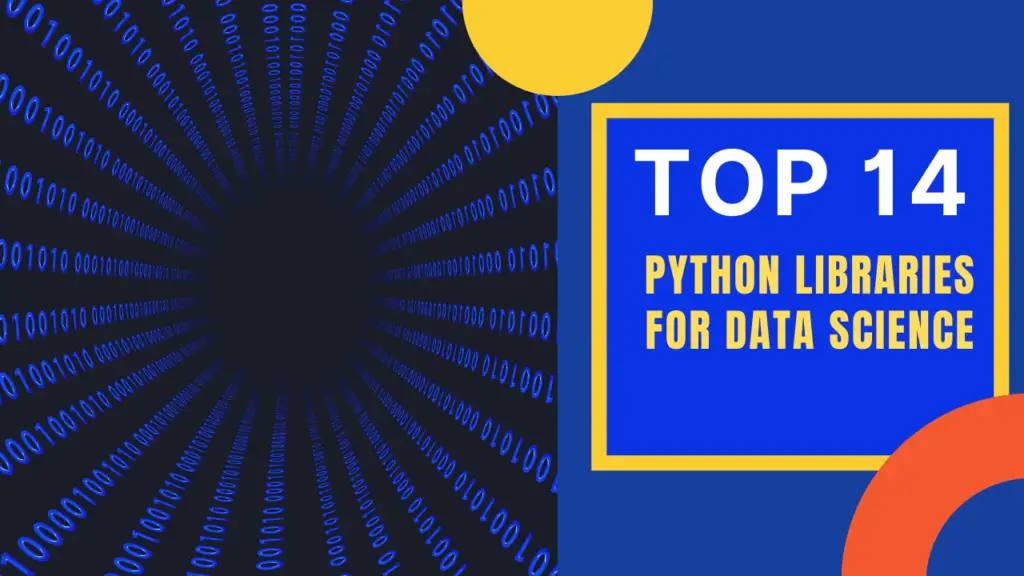Python is the most popular and demanding language in the Computer world. In 2018, it’s been reported that python is used by 66% of data scientists on daily basis. It clearly shows it’s the number one programming language in data science because of its simplicity and it integrates easily with other software and models in the computer world.
What is Library in Programming Language?
It’s a collection of configured data, pre-written codes, or functions that are used by the developers or programmers to assist them in their software development, applications, or programs.

Top 14 Python Libraries for Data Science
There are many libraries used in Python. Some of them are listed below
1. NumPy:
This library is being used to produce arrays. Its work is to divide data and manipulate it for machine learning. In machine learning, there are several set of data which contains hundreds of number, which is very difficult to analyze and iterate them one by one but with the help of NumPy, its simplifies everything.
2. SciPy:
When it comes to scientific computing, SciPy provides the modules like integration, linear algebra, optimization, derivations, and statistics which are heavily used in the field of Mathematics, Science, and Engineering.
It’s the advanced form of NumPy which is used in the above-mentioned fields. This library helps in ample documentation in a really easy way.
3. Matplotlib:
This library is used to handle large datasheets. It is also used for visualizing the values. It visualizes the data in 2-D diagrams and graphics. The value of this library in data science is very high because due to which it can compete with scientific tools i.e., Mat Lab and Mathematica. Matplotlib offers object-oriented API to developers to embed plots to applications.
4. Pandas:
According to programmers, Pandas should be mastered. It provides data exploration to data visualization. It helps the developers to work with 2 things i.e. “labeled” and “relational” data. It consists of two main data structures: “Series” and “Data Frames”. Pandas allow developers to convert the data structures to data frame objects.
5. Seaborn:
It’s based on Matplotlib. Most data scientists prefer this library over Matplotlib because it’s advanced and it offers a high-level interface for the gathering of drawing informative graphics. To summarize data in visualizing statistical models i.e. heat maps and other types, seaborn serves as the best machine learning tool in this area.
6. Plotly:
One of the finest libraries which offer data visualization tools is Plotly. In interactive web applications, it works very efficiently. Creators of this library are expanding this library with new features and graphics to support new linked views, animations, and integrations.
7. Tensor Flow:
The most popular library for machine and deep learning is Tenser Flow. It is developed by Google Brain. For tasks like voice recognition, text to speech, object identification, and many others, tenser flow is the best. It helps in handling multiple data sets by working with artificial neural networks. It is also expanding, new releases include fixes in security vulnerabilities and improvements in the integration of Tensor flow with other software or tools.
8. Scrapy:
Scrapy is popular because of its framework which is used for large-scale web scraping. Scrapy gives all the tools for extracting the data from the documents or web pages efficiently, then processing them and storing that data in a structured way.
9. BeautifulSoup:
To web crawl and data scraping, BeautifulSoup is there to solve this. This library is used by the developers to collect data from the internet which is available in HTML or XML. After collecting, programmers can navigate documents or web pages and find the important data from those documents in no time.
10. Keras:
It is a deep learning application programming interface. It is developed basically to enable fast experimentation. It provides a much better User Experience that is the reason it is preferred over Tenser Flow. It is also very good at understanding compact systems. It is very easy to use because it is developed in Python.
11. SciKit-Learn:
SciKit is a group of features and packages in SciPy Stack that is created for specific working – for example, image processing. It is used in the making of machine learning models. The most crucial and important tool is this library in data science that can overcome any hurdle. It contains such efficient tools for machine learning and modelings as clustering, regression, dimensionality reduction, and many more.
12. PyTorch:
PyTorch’s framework is best for those who want deep learning of data science. It is used for many tasks like creating dynamic computational graphs, calculating the gradients, performing the tensor computations. This library is written in C. PyTorch also features cloud support and a robust ecosystem.
13. Statsmodels:
It is a Python module that offers classes and functions for many statistical models, conducting statistical tests, and data exploration. The results are gathered by this module then tested against the existed statistical data to check whether the results are correct or not.
14. Requests:
The request library is used for making requests in Python. It extracts the complexion of making requests behind simple APIs so a developer can consume data and interact with the services.
People are also reading:
What is Computer Vision? Examples, Applications, Techniques
